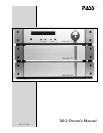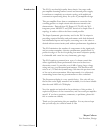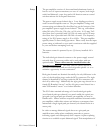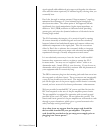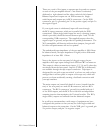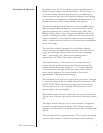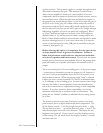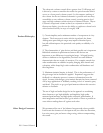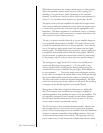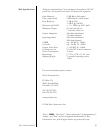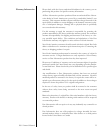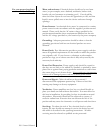
6
X0.2 Owner’s Manual
In application the X 0.2’s front panel controls and alphanumeric
display are quite straight forward, and intuitive. We encourage you
to become familiar with their operation prior to establishing any
input connections with this unit. Experience indicates that engaging
in a few minutes of exploration and playtime will add much to your
ultimate enjoyment of this exceptional Pass Labs product.
The two front panel mode switches move the pre-amplifier and its
display through 9 different functions. From virtual left to virtual
right these functions are as follows: Volume, Input, Mute, Tape,
Balance, Display, Mono, Unity, Amp (power-amplifier turn on/off
control). Actuating the mode < switch moves the function to the
feature immediately to the virtual left, and conversely actuating the
mode > switch moves the function to the feature that is immediately
to the virtual right.
The two Select switches (designated by up and down pointing
arrows) then alter the displayed active function. The select arrows
toggle the following functions either off or on (the up pointing
arrow ^ representing “on” and the down pointing arrow v
representing “off ”) Mute, Tape, Mono, and Amp.
The leftmost function as selected by the two mode switches is
volume, and the up/down arrows select 72 steps incrementally,
indicated on the fluorescent display as 0 - 71. A more traditional
knob, located at the far right of the front panel, which is always
active, exactly duplicates this control function. Each step is
approximately 1 dB of incremental change.
The next mode to the right is the input selector, for inputs 1 through
5. Input 5 is unique in that it is linked with the Unity function. (The
UNITY FUNCTION is discussed at length later in this manual.)
The two select arrows (^ & v) logically control selections of the
various inputs to the pre-amplifier.
The channel balance function is affected by the up and down arrows.
The up arrow is balance right and the down arrow conversely balance
left.
The display function chooses one of three iterations of brightness
for the front panel fluorescent display. These choices of display
brightness are selectable by the up/down arrows; they are bright, dim
and off.
The unity function bears special attention. This control is associated
only with input number 5 and has two positions selected with the
Description of Operation



